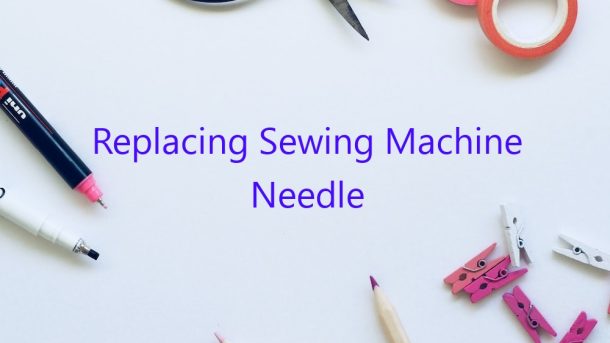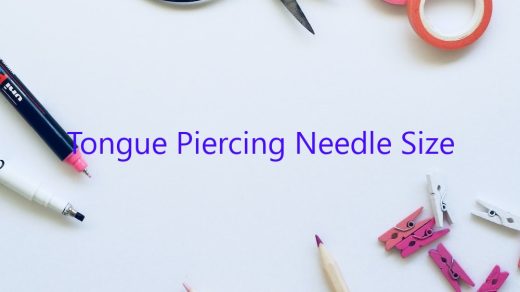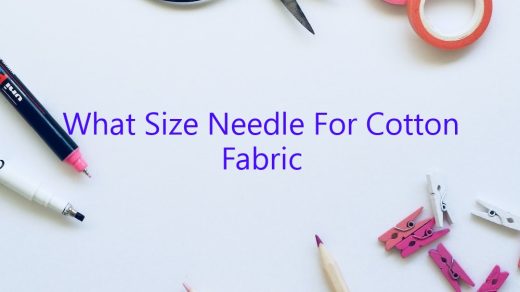Replacing a sewing machine needle is a quick and easy process that can be done in just a few minutes. It is important to replace the needle regularly, as a dull needle can damage fabric and lead to skipped stitches.
The first step is to identify the type of needle that is currently installed in the sewing machine. Many machines have a needle chart located on the side or the bottom of the machine. If the needle is not visible, the chart may list the type of needle by its size.
Next, find the corresponding needle size in the replacement needle pack. There are several different types of needles available, so be sure to choose the right one. The most common types of needles are universal needles, which can be used for most fabrics; ballpoint needles, which are designed for knits; and sharpoint needles, which are designed for tight seams and thin fabrics.
Once the needle is chosen, remove the old needle by unscrewing it from the sewing machine. Be sure to hold onto the old needle as it will be sharp. Then, insert the new needle into the machine in the same way the old needle was removed. Tighten the screw to secure the needle in place.
Now the machine is ready to be used. Be sure to test the needle on a scrap of fabric to make sure it is sharp and properly aligned.
Contents [hide]
Do all sewing machine needles fit all sewing machines?
When it comes to sewing machines, one of the most commonly asked questions is whether or not all sewing machine needles fit all sewing machines. The answer to this question is actually a little bit complicated.
The truth is that most sewing machine needles do fit most sewing machines. However, there are a few exceptions. For example, some older sewing machines use needles that are no longer in production. In addition, some specialty needles, such as those designed for use with denim, may not fit all machines.
If you’re not sure whether or not a particular needle will fit your machine, it’s best to check the manufacturer’s specifications or consult a sewing machine repair technician. In most cases, it’s safe to assume that most needles will fit most machines, but it’s always best to check just to be sure.
When should I replace my sewing machine needle?
There are a few telltale signs that it might be time to replace your sewing machine needle. If the needle is bent, cracked, or has rough edges, it’s definitely time for a new one. Additionally, if the needle skips stitches, makes noises, or breaks thread, it’s also time for a new needle.
It’s generally a good idea to replace the needle every time you change the thread, or every 8-10 hours of use. However, this varies depending on the type of fabric you’re sewing and the type of needle you’re using.
There are a variety of different types of needles available, each of which is best suited for a specific type of fabric. Universal needles are best for general use, while needles designed for specific types of fabric – such as denim, silk, or leather – will produce better results.
If you’re not sure which type of needle to use, or if you’re not sure whether it’s time to replace the needle, consult your sewing machine’s manual or the manufacturer’s website. They’ll be able to provide specific instructions on how to choose the right needle and when to replace it.
Is it necessary to turn the power off when changing the sewing needle?
It is not necessary to turn the power off when changing the sewing needle.
How do I change the needle on my Singer sewing machine?
Singer sewing machines are some of the most popular machines on the market. They are known for their durability and ease of use. One of the most important things to keep your Singer sewing machine running well is to keep the needle in good condition. Here is how to change the needle on your Singer sewing machine.
1. Begin by unplugging your machine from the power source.
2. Open the cover of the machine and locate the needle clamp. The needle clamp is a small, silver lever located on the side of the machine.
3. Use the needle clamp to loosen the needle by rotating it counterclockwise.
4. Carefully remove the old needle from the machine.
5. Insert the new needle into the machine. The point of the needle should be facing the back of the machine.
6. Tighten the needle clamp by rotating it clockwise.
7. Close the cover of the machine.
8. Plug your machine back into the power source.
Your Singer sewing machine is now ready to use.
How do you tell what size a sewing machine needle is?
There are a few ways that you can determine the size of a sewing machine needle. One way is to measure the width of the needle at its widest point. Another way is to measure the length of the needle from the base to the tip. The size of the needle is usually written on the needle itself.
What is the most common sewing machine needle size?
What is the most common sewing machine needle size?
The most common sewing machine needle size is size 14. This size is great for general purpose sewing.
How do I know if my sewing machine needle is dull?
When it comes to sewing, a dull needle can be a real pain. Not only will it make it harder to sew through your fabric, but it can also cause damage to both your fabric and your machine. So, how do you know if your sewing machine needle is dull?
One way to tell is if your stitches are consistently misshapen, no matter how hard you try to make them look perfect. Another telltale sign is if your fabric starts to pucker or snag, especially around the needle area. If you notice either of these things happening, it’s time to change your needle.
Luckily, changing your needle is a quick and easy process. First, make sure your machine is unplugged and that all the thread is cut from the needle. Then, hold the needle with the flat side facing up and twist it a quarter turn to the left. This will loosen the needle. Finally, pull the old needle out and insert the new one by pushing it in until it clicks into place. Twist it a quarter turn to the right to secure it.
Now, it’s time to test your new needle. Sew a few stitches in a scrap piece of fabric to make sure it’s sewing evenly. If it is, you’re good to go! If not, try adjusting the tension on your machine.
As long as you keep your sewing machine needles sharp, your fabric will look great and your machine will stay in good condition. So, be sure to change your needle regularly and enjoy your sewing projects!




